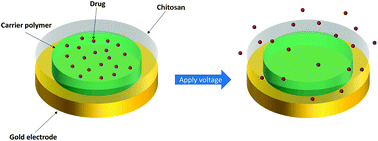Our official English website, www.x-mol.net, welcomes your feedback! (Note: you will need to create a separate account there.)
Electrically controlled drug release using pH-sensitive polymer films†
Nanoscale ( IF 6.7 ) Pub Date : 2018-05-15 00:00:00 , DOI: 10.1039/c8nr02602e S. Ephraim Neumann 1, 2, 3, 4, 5 , Christian F. Chamberlayne 1, 2, 3, 4 , Richard N. Zare 1, 2, 3, 4
Nanoscale ( IF 6.7 ) Pub Date : 2018-05-15 00:00:00 , DOI: 10.1039/c8nr02602e S. Ephraim Neumann 1, 2, 3, 4, 5 , Christian F. Chamberlayne 1, 2, 3, 4 , Richard N. Zare 1, 2, 3, 4
Affiliation

|
Drug delivery systems (DDS) that allow spatially and temporally controlled release of drugs are of particular interest in the field of drug delivery. These systems create opportunities for individually tailored doses of drugs to be administered as well as reduce side effects by localizing the initial drug dose to the organ of interest. We present an electroresponsive DDS in the form of a bioresorbable nanocomposite film which operates at low voltages (<−2 V). The method is based on electrochemically generating local pH changes at an electrode surface to induce dissolution of a pH-sensitive polymer, which is used as the carrier material. We previously demonstrated this proof-of-concept using a poly(methyl methacrylate-co-methacrylic acid) (co-PMMA) copolymer commercially marketed as Eudragit S100 (EGT). However, as EGT is soluble at a pH above 7, experiments were performed in isotonic saline solutions (pH ∼ 6.4). In this work, we have synthesized co-PMMA with a variety of monomer ratios to shift the solubility of the copolymer to higher pH values, and developed a polymer that can be used under physiologically relevant conditions. The generalizability of this system was demonstrated by showing controlled release of different drug molecules with varying parameters like size, hydrophobicity, and pKa. Fluorescein, a hydrophilic model compound, meloxicam, a hydrophobic anti-arthritic medication, curcumin, a small molecule with anti-cancer therapeutic potential, and insulin, a polypeptide hormone used in the treatment of hypoglycemia, could all be released on demand with minimal leakage. The drug loading achieved was ∼32 wt% by weight of the co-polymer.
中文翻译:

使用pH敏感的聚合物薄膜进行电控药物释放†
允许在空间和时间上控制释放药物的药物输送系统(DDS)在药物输送领域特别受关注。这些系统通过将初始药物剂量定位在目标器官上,为个体定制剂量的药物给药创造了机会,并减少了副作用。我们提出了一种可生物吸收的纳米复合薄膜形式的电响应DDS,该薄膜可在低电压(<-2 V)下工作。该方法基于在电极表面上电化学产生局部pH变化以诱导pH敏感聚合物的溶解,该pH敏感聚合物用作载体材料。我们以前表明这证明的概念使用的聚(甲基丙烯酸甲酯-共-甲基丙烯酸)(共-PMMA)共聚物,商品名为Eudragit S100(EGT)。但是,由于EGT在pH高于7时可溶,因此在等渗盐溶液(pH约为6.4)中进行了实验。在这项工作中,我们合成了具有各种单体比率的共聚-PMMA,以将共聚物的溶解度转移至更高的pH值,并开发了可在生理相关条件下使用的聚合物。通过显示具有不同参数(如大小,疏水性和p K a)的不同药物分子的控制释放,证明了该系统的通用性。。荧光素(一种亲水性模型化合物),美洛昔康(一种疏水性抗关节炎药物),姜黄素(一种具有抗癌治疗潜力的小分子)以及胰岛素(一种用于治疗低血糖症的多肽激素)都可以按需释放,且泄漏最少。达到的药物载量为共聚物重量的〜32wt%。
更新日期:2018-05-15
中文翻译:

使用pH敏感的聚合物薄膜进行电控药物释放†
允许在空间和时间上控制释放药物的药物输送系统(DDS)在药物输送领域特别受关注。这些系统通过将初始药物剂量定位在目标器官上,为个体定制剂量的药物给药创造了机会,并减少了副作用。我们提出了一种可生物吸收的纳米复合薄膜形式的电响应DDS,该薄膜可在低电压(<-2 V)下工作。该方法基于在电极表面上电化学产生局部pH变化以诱导pH敏感聚合物的溶解,该pH敏感聚合物用作载体材料。我们以前表明这证明的概念使用的聚(甲基丙烯酸甲酯-共-甲基丙烯酸)(共-PMMA)共聚物,商品名为Eudragit S100(EGT)。但是,由于EGT在pH高于7时可溶,因此在等渗盐溶液(pH约为6.4)中进行了实验。在这项工作中,我们合成了具有各种单体比率的共聚-PMMA,以将共聚物的溶解度转移至更高的pH值,并开发了可在生理相关条件下使用的聚合物。通过显示具有不同参数(如大小,疏水性和p K a)的不同药物分子的控制释放,证明了该系统的通用性。。荧光素(一种亲水性模型化合物),美洛昔康(一种疏水性抗关节炎药物),姜黄素(一种具有抗癌治疗潜力的小分子)以及胰岛素(一种用于治疗低血糖症的多肽激素)都可以按需释放,且泄漏最少。达到的药物载量为共聚物重量的〜32wt%。


























 京公网安备 11010802027423号
京公网安备 11010802027423号